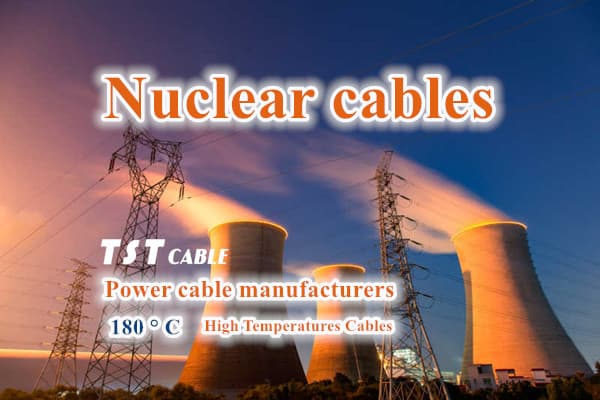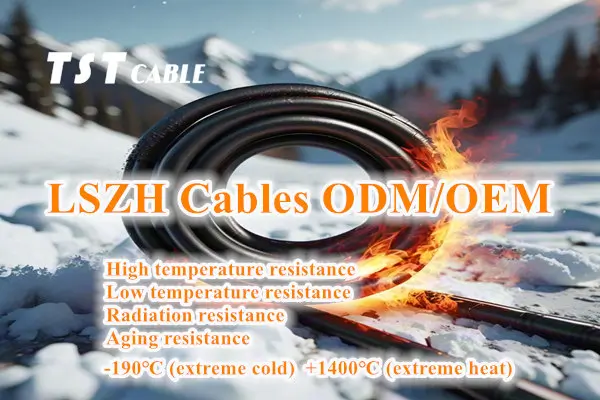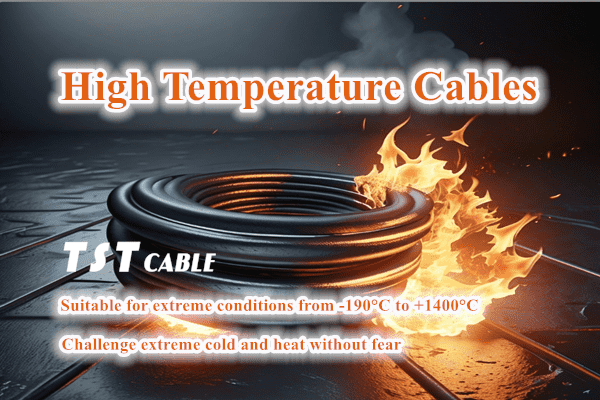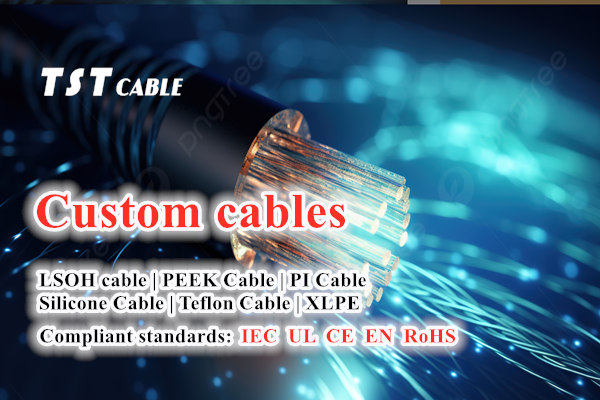
Radiation-resistant PEEK (polyether ether ketone) cables are high-performance cables designed for extreme environments that take advantage of the excellent physical, chemical and electrical properties of the PEEK material and are specifically optimised to withstand the effects of the radiation environment. Below TST CABLES gives you an overview of the world’s latest technology in radiation resistant PEEK cables.
Core Material Properties of Radiation Resistant Cables
PEEK (polyether ether ketone): This is a high-performance thermoplastic engineering plastics, known for its excellent resistance to high temperatures (continuous use temperature up to 240 ℃), high strength, high rigidity, chemical corrosion resistance, self-lubricating and excellent dimensional stability.PEEK also has a very good flame retardant, combustion of the smoke released by a small and does not contain halogens, it is a kind of environmentally friendly materials.
Radiation-resistant cable performance
Radiation stability: the key to radiation-resistant PEEK cable in its PEEK insulation and sheath materials can effectively resist γ-rays, X-rays and other high-energy radiation, even in the long-term exposure to radiation, but also to maintain the stability of its physical properties and electrical properties, reduce material degradation and aging.
Long-term usability: In nuclear reactors, radioisotope processing, space exploration and other high-radiation environments, PEEK cables can maintain their electrical insulation properties to ensure the reliable operation of the equipment and extend the service life.
Application areas of radiation-resistant cables
Nuclear energy industry: used for signal transmission and power connection of nuclear reactor control system, including winding coils of nuclear island drive mechanism, monitoring sensor lines, etc.
Medical equipment: in radiotherapy equipment, nuclear medicine imaging system, radiation resistant PEEK cables can ensure the accurate transmission of signals, while protecting patients and healthcare workers from the effects of radiation.
Aerospace: Electronic systems on space vehicles and satellites require radiation-resistant cables to ensure the stability of data communication and power supply.
Scientific research: In particle accelerators, nuclear physics experiments and other high-energy physics research, as a stable bridge connecting instruments and equipment.
Military applications: in military facilities such as submarines, radar stations, etc., radiation resistant PEEK cables can ensure the normal operation of the system in a nuclear war or EMP environment.
Radiation resistant cable structure design
Conductor: Silver-plated copper wire is usually used to improve electrical conductivity and corrosion resistance.
Insulation: PEEK material is used as an insulating layer to ensure good insulation properties even under extreme temperature and radiation conditions.
Sheathing: PEEK is also used, or in combination with other radiation resistant materials, to enhance the overall protection of the cable, and sometimes special protective layers are added to increase mechanical strength and environmental resistance.
Special structure: According to the application requirements, it may be designed with multi-layer shielding structure to further improve the cable’s anti-interference ability and overall reliability.
Radiation resistant cable processing and customisation
Radiation resistant PEEK cables often require highly specialised techniques and equipment during production. Manufacturers often customise cables according to the specific needs of the end application, including but not limited to:
Size and cross-section: the diameter, cross-section shape and number of cores of the cable are customised according to the power to be transmitted, the type of signal and the installation space.
Reinforcements: To further enhance the mechanical strength and abrasion resistance of the cable, glass fibres, carbon fibres or other reinforcing fibres can be added to the PEEK base material.
Special fillings: Special compounds are added to the insulation or sheath to improve the cable’s resistance to radiation, high temperatures or to specific environments.
Water and Moisture Barrier: For wet or underwater applications, cables may need to be designed with a waterproof barrier to protect the internal structure from moisture.
Splices and terminals: The connecting parts of radiation resistant PEEK cables are also a design priority, and high-quality splices and terminals made of radiation resistant materials need to be selected to ensure the sealing and reliability of the entire system.
Testing and Certification of Radiation Resistant Cables
To ensure that radiation-resistant PEEK cables meet the most stringent performance standards, they undergo a series of rigorous tests before leaving the factory:
Radiation Resistance Test: Simulates the actual use environment and verifies the performance stability of the cable under prolonged radiation exposure.
High temperature and high humidity test: to assess the performance of cables under extreme temperature and humidity conditions.
Mechanical Strength Test: Includes tensile, bending and torsion tests to ensure the physical durability of the cable.
Electrical performance testing: measuring insulation resistance, dielectric strength, signal transmission loss, etc. to ensure that the electrical performance is up to standard.
Safety and environmental certification: such as through UL, VDE, RoHS and other international certifications to prove the safety of the cable and environmental compliance.
Radiation Resistant Cable Maintenance and Replacement
TSTCABLES reminds our larger user friends that maintenance of radiation resistant PEEK cables is relatively simple, but they need to be inspected regularly for external damage, especially when used in harsh environments. Due to the high performance properties of the PEEK material, replacement intervals are usually long, but any damage affecting performance should be replaced as soon as it is detected to avoid potential safety risks.
TST CABLES, the world’s leading supplier of radiation resistant PEEK cables
TST CABLES radiation-resistant PEEK cables have become an indispensable component in many high-tech and critical fields due to their stability and reliability under extreme conditions, and their development and application demonstrate the continuous progress of material science and engineering technology.
Every inch of radiation-resistant PEEK cable is a symbol of respect for life and the promise of the future. In the depths of nuclear power plants, the front end of space exploration, and beside the precision instruments of medical radiation, TST CABLES silently guards to ensure the safety of equipment and personnel. It is not just a cable, it is a bridge connecting dream and reality, and a testimony of human wisdom against the limit of nature.
Choosing TST CABLES radiation-resistant PEEK cables is to put on an impenetrable armour for your equipment, and to take every step firmly in the unknown and challenges.TST CABLES, in the name of science and technology, guards the safety and lights up the future.
If you are in an environment where nuclear radiation exceeds safety standards, you can contact us for customised professional solutions. If you need radiation resistant PEEK cables, PI cables, low smoke halogen free flame retardant cables, please feel free to contact us by email.




